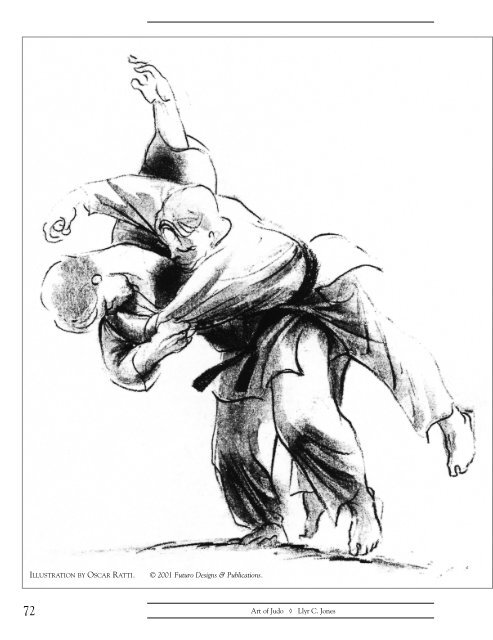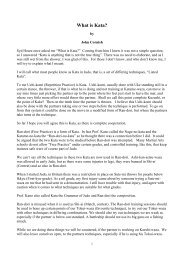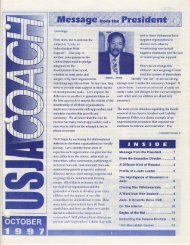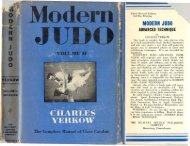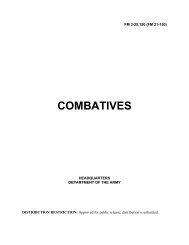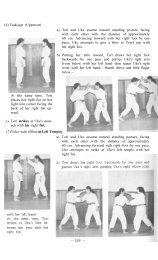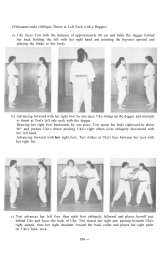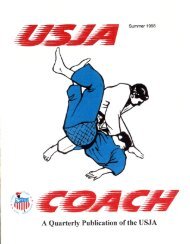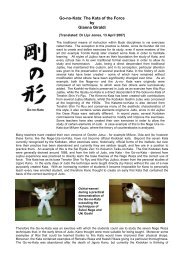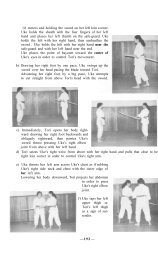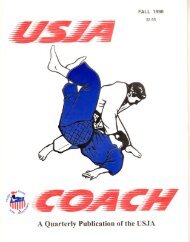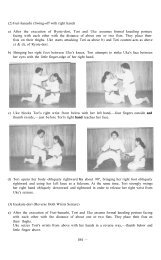Competition, Kata, and the Art of Judo - Judo Information Site
Competition, Kata, and the Art of Judo - Judo Information Site
Competition, Kata, and the Art of Judo - Judo Information Site
You also want an ePaper? Increase the reach of your titles
YUMPU automatically turns print PDFs into web optimized ePapers that Google loves.
ILLUSTRATION BY OSCAR RATTI.<br />
© 2001 Futuro Designs & Publications.<br />
72 <strong>Art</strong> <strong>of</strong> <strong>Judo</strong> ◊ Llyr C. Jones
COMPETITION, KATA<br />
AND THE ART OF JUDO<br />
LLYR C. JONES, PH.D.<br />
▲▼▲<br />
INTRODUCTION<br />
The word “judo” comes from a combination <strong>of</strong> two Japanese words—ju<br />
meaning gentle or supple <strong>and</strong> do meaning path or way. This literally defines<br />
judo as <strong>the</strong> “gentle way.”<br />
At <strong>the</strong> level <strong>of</strong> first principles, <strong>the</strong> essence <strong>of</strong> Kodokan * judo is turning an<br />
opponent’s strength against himself <strong>and</strong> overcoming <strong>the</strong> opponent through<br />
skill ra<strong>the</strong>r than sheer strength (Kano, 1986). This <strong>the</strong>ory is captured by <strong>the</strong><br />
Japanese expression ju yoku go o seisu—usually translated as “s<strong>of</strong>tness overcomes<br />
hardness,” “flexibility overcomes stiffness,” “gentleness controls<br />
strength,” or “win by yielding.”<br />
Watching <strong>the</strong> seemingly effortless combination <strong>of</strong> grace, technique, <strong>and</strong><br />
power <strong>of</strong> a true judo expert in action, it would be very easy (but very wrong) to<br />
underestimate <strong>the</strong> intense physical <strong>and</strong> mental dem<strong>and</strong>s that judo makes upon<br />
its exponents. Achieving excellence in judo dem<strong>and</strong>s considerable single<br />
mindedness. Achieving mastery <strong>of</strong> all <strong>of</strong> <strong>the</strong> throwing, grappling, <strong>and</strong> striking<br />
techniques that makes up <strong>the</strong> system dem<strong>and</strong>s intensive <strong>and</strong> dem<strong>and</strong>ing training<br />
over an extended period <strong>of</strong> time under <strong>the</strong> guidance <strong>of</strong> an experienced <strong>and</strong><br />
knowledgeable teacher.<br />
<strong>Judo</strong> has been well established in <strong>the</strong> West since <strong>the</strong> early 1900’s <strong>and</strong> is<br />
now practiced in almost every country in <strong>the</strong> world. The aim <strong>of</strong> this paper,<br />
however, is to question <strong>the</strong> direction that judo has taken in <strong>the</strong> West (especially<br />
in <strong>the</strong> United Kingdom) <strong>and</strong> to challenge whe<strong>the</strong>r a significant re-orientation<br />
is now required. Where specific statistics or statements are used to<br />
support an argument, data <strong>and</strong> examples from <strong>the</strong> British <strong>Judo</strong> Association<br />
(BJA)—<strong>the</strong> national governing body for <strong>the</strong> Olympic sport <strong>of</strong> judo in <strong>the</strong><br />
United Kingdom—are used.<br />
*KODOKAN: THE HEADQUARTERS<br />
OF JUDO, ORIGINALLY FOUNDED<br />
IN 1882 BY KANO JIGORO WHO<br />
HIMSELF HAD ESTABLISHED JUDO.<br />
Journal <strong>of</strong> Asian Martial <strong>Art</strong>s ◊ Volume 14 Number 3 - 2005 73
THE STATE OF JUDO TODAY<br />
As a starting point, it is worthwhile stating <strong>the</strong> definition <strong>of</strong> judo as provided<br />
by <strong>the</strong> Kodokan New Japanese-English Dictionary <strong>of</strong> <strong>Judo</strong> (Kawamura &<br />
Daigo, 2000):<br />
<strong>Judo</strong>: A martial art formulated by Jigoro Kano based on his<br />
reformulation <strong>and</strong> adaptation <strong>of</strong> several classical jujutsu systems<br />
as well as his own philosophical ideals.<br />
Such a definition may not resonate well with <strong>the</strong> image <strong>of</strong> judo promoted<br />
by <strong>the</strong> <strong>of</strong>ficial accredited national governing bodies—i.e., those belonging to<br />
<strong>the</strong> International <strong>Judo</strong> Federation (IJF)—<strong>the</strong> majority <strong>of</strong> whom seem to be<br />
actively encouraging <strong>the</strong> distancing <strong>of</strong> judo from its martial arts origins. In<br />
<strong>the</strong>se early years <strong>of</strong> <strong>the</strong> 21st century, it is difficult to challenge <strong>the</strong> view that in<br />
<strong>the</strong> West (<strong>and</strong> in <strong>the</strong> United Kingdom in particular) judo is promoted one<br />
dimensionally, as a combat sport—organized around championships <strong>and</strong> competition—<strong>of</strong>ten<br />
for competition’s sake. To reinforce this sporting dimension,<br />
<strong>the</strong> competitive style <strong>of</strong> judo is <strong>of</strong>ten referred to as Olympic <strong>Judo</strong> or Performance<br />
<strong>Judo</strong> (a style in its own right).<br />
A direct consequence <strong>of</strong> <strong>the</strong> leadership <strong>and</strong> policies <strong>of</strong> <strong>the</strong> accredited<br />
judo governing bodies is that, for <strong>the</strong> majority <strong>of</strong> judo practitioners, judo is<br />
now just about medals <strong>and</strong> prizes. These bodies measure <strong>the</strong> health <strong>of</strong> <strong>the</strong>ir<br />
country’s judo simply in terms <strong>of</strong> results at major championships <strong>and</strong> accordingly<br />
focus <strong>the</strong>ir investment only on <strong>the</strong> h<strong>and</strong>ful <strong>of</strong> elite athletes who have<br />
<strong>the</strong> potential to be World or Olympic medalists. Be<strong>the</strong>rs (n.d.) recognizes<br />
this issue:<br />
It seems that some modern judo leaders have narrowed <strong>the</strong><br />
objective <strong>of</strong> judo to only “Contest Pr<strong>of</strong>iciency.” For many,<br />
world-wide judo has become equated with contest pr<strong>of</strong>iciency.<br />
Although this belief is today wide-spread, it is <strong>the</strong> very thing that<br />
Dr. Kano warned against throughout his life. Dr. Kano stated,<br />
“<strong>Judo</strong> should only be a means to <strong>the</strong> end <strong>of</strong> skill <strong>and</strong> principles<br />
for higher self-development, <strong>and</strong> any ‘drift’ toward ‘contest’ judo<br />
as <strong>the</strong> ‘sole’ interpretation <strong>of</strong> judo should be carefully regulated.”<br />
This “drift” has become a major focus among many well intended<br />
judoka [practitioners], but in <strong>the</strong> minds <strong>of</strong> many sensei [teachers],<br />
technique has suffered <strong>and</strong> judo has become (more <strong>of</strong>ten than not)<br />
a sport in which “win at all costs” is <strong>the</strong> underlying objective.<br />
It is evident that <strong>the</strong> strategy <strong>of</strong> focusing on Performance <strong>Judo</strong> must<br />
now be challenged, as judo today is an activity in decline. In <strong>the</strong> United<br />
Kingdom, this is manifested by decreasing adult membership <strong>of</strong> <strong>the</strong> British<br />
<strong>Judo</strong> Association—75% <strong>of</strong> <strong>the</strong> BJA membership is under <strong>the</strong> age <strong>of</strong> 16<br />
(British <strong>Judo</strong> Association, n.d.)—<strong>and</strong> <strong>the</strong> continuing lack <strong>of</strong> consistent <strong>and</strong><br />
substantial success <strong>of</strong> British judo players in international competition<br />
despite all <strong>the</strong> effort directed to this end.<br />
74 <strong>Art</strong> <strong>of</strong> <strong>Judo</strong> ◊ Llyr C. Jones
It is a matter <strong>of</strong> additional concern that <strong>the</strong> governing bodies have<br />
overwhelmingly biased <strong>the</strong>ir rank promotion structures (i.e. grading) toward<br />
accelerating <strong>the</strong> grade advancement <strong>of</strong> those who are successful in competition,<br />
with <strong>of</strong>ten only lip service being plaid to <strong>the</strong> breadth <strong>and</strong> depth <strong>of</strong> an<br />
individual’s technical judo knowledge. Again, Be<strong>the</strong>rs (n.d.) writes:<br />
This emphasis on “Contest Pr<strong>of</strong>iciency” has caused <strong>the</strong> true meaning<br />
or purpose <strong>of</strong> judo to be unclear <strong>and</strong> somewhat out <strong>of</strong> proportion to<br />
what was intended by Dr. Kano. This problem is surfaced nowhere<br />
more clearly than in “notion” that contest victories are rewarded with<br />
rapid rank promotions.<br />
Currently <strong>the</strong>re is little prospect for grade advancement for those who<br />
(through age, physical condition, or personal preference) wish to practice<br />
judo as an art as opposed to a sport. This is, <strong>of</strong> course, with <strong>the</strong> notable exception<br />
<strong>of</strong> <strong>the</strong> promotions that governing body <strong>of</strong>ficials <strong>and</strong> administrators seem<br />
to receive as a matter <strong>of</strong> course. The risk one runs with such a policy is a<br />
resultant judo hierarchy that is both one-dimensional in its knowledge <strong>and</strong><br />
skewed in its priorities.<br />
It is especially disappointing that those judo players who prefer to focus<br />
<strong>the</strong>ir study on <strong>the</strong> more traditional <strong>and</strong> technical aspects <strong>of</strong> judo (e.g. forms<br />
or kata) have become tagged with <strong>the</strong> label recreational players—implying<br />
that <strong>the</strong>y are somehow inferior to contest players <strong>and</strong> not worthy <strong>of</strong> attention<br />
or recognition.<br />
BACK TO BASICS<br />
This author <strong>and</strong> o<strong>the</strong>r writers (Watanabe, 2003; Burkl<strong>and</strong>, 1998) advocate<br />
<strong>the</strong> <strong>the</strong>sis that judo in <strong>the</strong> West has lost its way <strong>and</strong> that <strong>the</strong>re is a real<br />
need for it to return to its martial art roots. In doing so, <strong>the</strong> author’s aim for this<br />
paper is not to decry <strong>the</strong> considerable merits <strong>of</strong> Performance <strong>Judo</strong>—indeed success<br />
in contest over several traditional jujutsu schools was key in establishing<br />
Kodokan judo as an effective combat system (Kano, 1986). Ra<strong>the</strong>r, it is to<br />
argue that judo based solely on sport is not judo in toto <strong>and</strong> that <strong>the</strong> original <strong>and</strong><br />
arguably truer meaning <strong>of</strong> <strong>the</strong> art lies elsewhere.<br />
Elementary research will reveal that <strong>the</strong> underlying concept <strong>of</strong> judo as<br />
envisioned by Kano was that it was to be a means <strong>of</strong> (cooperative) physical <strong>and</strong><br />
social education—in simple terms, a training for life. Kano captured this principle<br />
<strong>of</strong> mutual welfare <strong>and</strong> prosperity via <strong>the</strong> maxim: you <strong>and</strong> I shining toge<strong>the</strong>r<br />
(jita kyo ei, mutual welfare <strong>and</strong> prosperity) (Kano, 1986).<br />
Indeed, with <strong>the</strong> overwhelming majority <strong>of</strong> those now practicing<br />
Performance <strong>Judo</strong>, it is reasonable to conclude that mainstream contemporary<br />
judo has now deviated significantly (<strong>and</strong> quite possibly permanently)<br />
from Kano’s original ideas. Smith (1999: 221) notes:<br />
The popularization <strong>and</strong> spread <strong>of</strong> judo has weakened Kano’s base so<br />
greatly, I see no chance <strong>of</strong> it ever recovering. <strong>Judo</strong> is now merely a<br />
jacketed wrestling sport. The competitive has ousted <strong>the</strong> cooperative.<br />
Journal <strong>of</strong> Asian Martial <strong>Art</strong>s ◊ Volume 14 Number 3 - 2005<br />
75
Figure 1<br />
Nage no <strong>Kata</strong><br />
© Photography by<br />
Bob Willingham.<br />
bob@twoj.org<br />
Bates (n.d.) argues that judo has two essential components—martial <strong>and</strong><br />
art. The martial component <strong>of</strong> judo can be related to combat through <strong>the</strong> way<br />
<strong>of</strong> <strong>the</strong> warrior (budo)—<strong>the</strong> contemporary representation <strong>of</strong> which is competition<br />
(shiai). In preparation for contest, <strong>the</strong> modern judo player focuses on <strong>the</strong><br />
development <strong>of</strong> physical conditioning <strong>and</strong> fitness, motivation, tactics, <strong>and</strong><br />
technique for <strong>the</strong> sole purpose <strong>of</strong> securing victory. Conversely, art can be<br />
defined as technical excellence <strong>and</strong> underst<strong>and</strong>ing <strong>of</strong> techniques developed<br />
through repeated practice (uchi-komi <strong>and</strong> nage-komi), free-practice (r<strong>and</strong>ori),<br />
<strong>and</strong> kata.<br />
<strong>Judo</strong> is, <strong>of</strong> course, both martial <strong>and</strong> art, but today <strong>the</strong> concept most people<br />
have <strong>of</strong> judo is martial. Martial represents but one small element <strong>of</strong> judo,<br />
yet almost without exception, most judo teachers focus on developing <strong>the</strong>ir<br />
students’ contest prowess <strong>and</strong> many believe it unnecessary to practice or even<br />
know any kata.<br />
REDISCOVERING KATA<br />
In <strong>the</strong> most general sense, any cooperative judo training between partners—e.g.<br />
a sequence <strong>of</strong> combinations or counters etc.—can be considered<br />
kata. However, a greater degree <strong>of</strong> focus is provided in a dictionary <strong>of</strong> judo<br />
(Kawamura & Daigo, 2000), which defines kata as follows:<br />
<strong>Kata</strong>: Formal movement pattern exercises containing idealised model<br />
movements illustrating specific combative principles.<br />
<strong>Kata</strong> is not unique to judo—it is recognized as a valuable training drill<br />
in most Japanese martial arts. The exact nature <strong>of</strong> kata training, however,<br />
76 <strong>Art</strong> <strong>of</strong> <strong>Judo</strong> ◊ Llyr C. Jones
Figure 2<br />
<strong>Kata</strong>me no <strong>Kata</strong><br />
varies from art to art. For example, karate kata is a solo form (like shadow boxing),<br />
whereas <strong>the</strong> judo kata are usually performed with partner—each partner<br />
having a specific role <strong>and</strong> performance objective depending on <strong>the</strong> kata. In<br />
judo, <strong>the</strong>re are kata for throwing techniques, groundwork techniques, selfdefense,<br />
as well as o<strong>the</strong>rs that illustrate <strong>the</strong> fundamental principles <strong>of</strong> judo<br />
(Kano, 1986; Otaki & Draeger, 1983; Leggett & Kano, 1982; Kawaishihi,<br />
1982; Fromm & Soames, 1982; Ohlenkamp, 2005).<br />
For completeness, a comprehensive list <strong>of</strong> <strong>the</strong> kata practiced<br />
in judo follows, toge<strong>the</strong>r with a summary description <strong>of</strong><br />
each (Ohlenkamp, 2005). Illustrations <strong>of</strong> techniques from <strong>the</strong><br />
seven most common kata are provided in Figures 1 to 7.<br />
Note that not all <strong>of</strong> <strong>the</strong>se kata were created by Kano or at<br />
<strong>the</strong> Kodokan <strong>and</strong>, as such, some are not <strong>of</strong>ficial Kodokan kata.<br />
Note also that <strong>the</strong> last six kata in <strong>the</strong> list are seldom practiced<br />
outside Japan <strong>and</strong>, even in Japan, few judo players would be<br />
familiar with <strong>the</strong>m.<br />
Figure 3<br />
Kime no <strong>Kata</strong><br />
• Nage no <strong>Kata</strong>: The kata <strong>of</strong> throws. Includes examples <strong>of</strong> h<strong>and</strong>,<br />
hip, leg, <strong>and</strong> sacrifice throws (Figure 1).<br />
• <strong>Kata</strong>me no <strong>Kata</strong>: The kata <strong>of</strong> grappling. Includes examples <strong>of</strong><br />
holds, strangles, <strong>and</strong> chokes <strong>and</strong> joint locks (Figure 2).<br />
• Kime no <strong>Kata</strong>: The kata <strong>of</strong> decision. This is <strong>the</strong> traditional judo<br />
self-defense kata. It includes both st<strong>and</strong>ing <strong>and</strong> kneeling defense<br />
against empty h<strong>and</strong>ed, knife, <strong>and</strong> sword attacks using strikes,<br />
chokes, joint locks, <strong>and</strong> throws (Figure 3). Kime no <strong>Kata</strong> is also<br />
known as Shinken Shobu no <strong>Kata</strong> (Combat Forms).<br />
Journal <strong>of</strong> Asian Martial <strong>Art</strong>s ◊ Volume 14 Number 3 - 2005<br />
77
Figure 4<br />
Kodokan Goshinjutsu<br />
Figure 5<br />
Ju no <strong>Kata</strong><br />
• Kodokan Goshinjutsu: The modern Kodokan<br />
self-defense kata (Figure 4). It includes defense<br />
against empty h<strong>and</strong>, knife, stick (jo), <strong>and</strong> pistol<br />
attacks using strikes, joint locks, <strong>and</strong> throws.<br />
• Ju no <strong>Kata</strong>: The kata <strong>of</strong> gentleness.<br />
It includes a number <strong>of</strong> attacks <strong>and</strong> defenses<br />
demonstrating <strong>the</strong> efficient redirection <strong>of</strong><br />
force <strong>and</strong> movement (Figure 5).<br />
• Itsutsu no <strong>Kata</strong>: The kata <strong>of</strong> five principles.<br />
This kata is intended for <strong>the</strong> demonstration<br />
<strong>and</strong> practice <strong>of</strong> body movement (tai sabaki)<br />
<strong>and</strong> for <strong>the</strong> application <strong>and</strong> redirection <strong>of</strong><br />
energy as in nature (Figure 6).<br />
• Koshiki no <strong>Kata</strong>: The ancient kata.<br />
This kata has its origins in Kito-ryu Jujutsu<br />
<strong>and</strong> demonstrates <strong>the</strong> techniques <strong>of</strong> fighting<br />
while wearing armor (kumiuchi), <strong>and</strong> is<br />
intended to illustrate <strong>the</strong> ancient origins<br />
<strong>of</strong> judo techniques (Figure 7).<br />
• Go no Sen no <strong>Kata</strong>: The kata <strong>of</strong> counters.<br />
This kata includes counter throws for a<br />
number <strong>of</strong> common techniques.<br />
• Kaeshi no <strong>Kata</strong>: An alternative kata<br />
<strong>of</strong> counters.<br />
• Seiryoku Zenyo Kokumin Taiiku:<br />
The national exercise based on <strong>the</strong> principles<br />
<strong>of</strong> maximum efficiency. This kata is atypical<br />
<strong>of</strong> judo in being a completely solo kata<br />
<strong>and</strong> comprises a variety <strong>of</strong> striking <strong>and</strong><br />
kicking techniques.<br />
• Kodokan Joshi Goshin-Ho:<br />
The Kodokan’s women’s self-defense kata.<br />
This kata includes a number <strong>of</strong> escapes<br />
from holds <strong>and</strong> grabs, some basic striking<br />
techniques, <strong>and</strong> one throw.<br />
• Renkoho: The kata <strong>of</strong> arresting techniques.<br />
This kata includes a number <strong>of</strong> control <strong>and</strong><br />
submission holds useful in restraining criminals.<br />
• Kimi Shiki: The kata <strong>of</strong> decision. This<br />
kata emphasizes <strong>the</strong> use <strong>of</strong> body movement<br />
in responding to attacks <strong>and</strong> includes both<br />
kneeling <strong>and</strong> st<strong>and</strong>ing defenses against<br />
empty h<strong>and</strong>, knife, <strong>and</strong> sword attacks.<br />
• Shobu no <strong>Kata</strong>: The kata <strong>of</strong> attack or contest.<br />
• Go no <strong>Kata</strong>: The kata <strong>of</strong> force or blows.<br />
This kata includes a variety <strong>of</strong> striking<br />
techniques (atemi waza).<br />
78 <strong>Art</strong> <strong>of</strong> <strong>Judo</strong> ◊ Llyr C. Jones
Figure 6<br />
Itsutsu no <strong>Kata</strong><br />
In nearly all martial art styles,<br />
forms are used as training tools from<br />
<strong>the</strong> novice stage upwards. In judo,<br />
however, its significance has long been<br />
under-emphasized <strong>and</strong> kata practice is<br />
now largely confined to very high<br />
grades or those who are not contestinclined.<br />
It is a tragedy <strong>of</strong> modern judo<br />
that, in <strong>the</strong> headlong rush into<br />
Olympic-type competition, most<br />
ranked black belt holders regard forms<br />
as an anachronism <strong>of</strong> little relevance to<br />
competition that should be discarded.<br />
The late Charles Palmer (<strong>the</strong>n BJA<br />
president) anticipated this situation<br />
when he wrote his 1982 foreword to<br />
Leggett <strong>and</strong> Kano’s kata text (Leggett<br />
& Kano, 1982):<br />
© Photography by Bob Willingham.<br />
bob@twoj.org<br />
Figure 7<br />
Koshiki no <strong>Kata</strong><br />
... too much emphasis is being<br />
placed on winning at all costs.<br />
Not enough time is being spent<br />
by judo players on acquiring <strong>the</strong><br />
vital self-discipline necessary<br />
to proper performance <strong>of</strong> <strong>the</strong><br />
sport, <strong>and</strong> <strong>the</strong> ability to<br />
continue enjoying it later in<br />
life after <strong>the</strong> ability to win<br />
contests has decreased.<br />
Journal <strong>of</strong> Asian Martial <strong>Art</strong>s ◊ Volume 14 Number 3 - 2005<br />
79
It was particularly insightful <strong>of</strong> Palmer to recognize that Performance<br />
<strong>Judo</strong> is age limited. Such sport judo is <strong>the</strong> domain <strong>of</strong> <strong>the</strong> young, whereas<br />
Kodokan judo (especially kata) can be done up until a very advanced age.<br />
A direct consequence <strong>of</strong> kata not being part <strong>of</strong> <strong>the</strong> normal activity <strong>of</strong><br />
most judo clubs is that <strong>the</strong> availability <strong>of</strong> people with <strong>the</strong> required knowledge<br />
<strong>and</strong> teaching skills is very limited. Today some <strong>of</strong> <strong>the</strong> better known judo forms<br />
are in serious danger <strong>of</strong> becoming extinct.<br />
For <strong>the</strong> reader’s interest, teaching sequences for two techniques from<br />
Kodokan Goshinjutsu—two-h<strong>and</strong>s hold (ryote dori) <strong>and</strong> uppercut (ago tsuki)—<br />
are provided in Figures 8 <strong>and</strong> 9. Similarly, teaching sequences for two techniques<br />
from <strong>the</strong> Koshiki no <strong>Kata</strong>—strength dodging (ryokuhi) <strong>and</strong> water wheel<br />
(mizu guruma)—are provided in Figures 10 <strong>and</strong> 11. These sequences were performed<br />
under <strong>the</strong> technical direction <strong>of</strong> world masters international kata judge<br />
Bob Thomas.<br />
Two-H<strong>and</strong> Hold<br />
8a Bob Thomas (right) <strong>and</strong> Eddie<br />
Cassidy approach each o<strong>the</strong>r.<br />
8b The attacker steps with his<br />
left foot forward into <strong>the</strong> proper<br />
distance to simultaneously grab <strong>the</strong><br />
defender’s wrists <strong>and</strong> tries to strike<br />
with his right knee to <strong>the</strong> groin.<br />
8c The defender bends his right arm hard toward his chest to free it <strong>and</strong>,<br />
8d continues his motion to strike <strong>the</strong> attacker’s right temple with <strong>the</strong><br />
knife-edge <strong>of</strong> his right h<strong>and</strong>.<br />
8e The defender grabs <strong>the</strong> attackers right wrist from <strong>the</strong> top with his right h<strong>and</strong> <strong>and</strong> applies<br />
an armlock (kote hineri). He steps back with his right foot <strong>and</strong> opens his body to his right.<br />
The defender clamps <strong>the</strong> attacker’s right arm under his left arm <strong>and</strong> twists <strong>the</strong> attacker’s wrist.<br />
The attacker is forced to submit, or have his arm broken.<br />
8a 8b 8c<br />
8d<br />
8e<br />
80 <strong>Art</strong> <strong>of</strong> <strong>Judo</strong> ◊ Llyr C. Jones
9a<br />
9c<br />
9b<br />
9d<br />
Uppercut<br />
9a Eddie Cassidy (right) <strong>and</strong> Bob<br />
Thomas approach each o<strong>the</strong>r.<br />
9b The attacker steps with his<br />
right foot forward into <strong>the</strong> proper<br />
distance to simultaneously throw a<br />
right uppercut. The defender steps<br />
slightly back with his left foot <strong>and</strong><br />
deflects <strong>the</strong> attacker’s uppercut<br />
from below with his right h<strong>and</strong>.<br />
9c Immediately, <strong>the</strong> defender grabs<br />
<strong>the</strong> attacker’s right wrist with his<br />
right h<strong>and</strong>, thumb down, <strong>and</strong> <strong>the</strong><br />
attacker’s elbow with his left h<strong>and</strong>.<br />
He twists <strong>the</strong> attacker’s wrist away<br />
from him <strong>and</strong> pushed <strong>the</strong> attacker’s<br />
elbow toward his face.<br />
9d While keeping his arm extended<br />
<strong>and</strong> locking <strong>the</strong> attacker’s elbow,<br />
<strong>the</strong> defender takes a big step<br />
forward with his left foot <strong>and</strong><br />
throws <strong>the</strong> attacker forward.<br />
10a<br />
10b<br />
Strength Dodging<br />
10a Eddie Cassidy (right) <strong>and</strong><br />
Bob Thomas approach each o<strong>the</strong>r.<br />
10b The attacker steps forward,<br />
left foot <strong>the</strong>n right, <strong>and</strong> attempts<br />
to grab <strong>the</strong> defender’s belt with a<br />
cross grip—right h<strong>and</strong> uppermost.<br />
The defender simultaneously pulls<br />
<strong>the</strong> attacker’s right arm forward.<br />
10c<br />
10c The defender pulls <strong>the</strong> attacker forward to his right side, while<br />
placing himself behind <strong>the</strong> attacker. He holds <strong>the</strong> attacker’s elbow<br />
bringing <strong>the</strong> arm upwards while holding <strong>the</strong> attacker’s upper left arm.<br />
10d<br />
10e<br />
10d The defender pulls <strong>the</strong> attacker<br />
backward to <strong>the</strong> right side while<br />
dropping to his left knee as <strong>the</strong><br />
attacker falls to<br />
<strong>the</strong> ground.<br />
10e As <strong>the</strong> defender<br />
kneels, <strong>the</strong> attacker<br />
sits up, keeping his<br />
legs spread with<br />
straight legs, toes up.<br />
Journal <strong>of</strong> Asian Martial <strong>Art</strong>s ◊ Volume 14 Number 3 - 2005<br />
81
Water Wheel<br />
11a Eddie Cassidy (right) <strong>and</strong><br />
Bob Thomas approach each o<strong>the</strong>r.<br />
11b The attacker steps forward with<br />
his left foot <strong>the</strong>n right, <strong>and</strong> attempts<br />
to seize <strong>the</strong> defender’s belt with a<br />
cross grip—right h<strong>and</strong> uppermost.<br />
The defender simultaneously pulls<br />
<strong>the</strong> attacker’s right arm forward.<br />
11c The attacker resists by pulling<br />
backward. The defender responds by<br />
changing his direction <strong>of</strong> movement,<br />
lifting <strong>the</strong> attacker’s right arm, <strong>and</strong><br />
presses it toward <strong>the</strong> attacker’s forehead.<br />
11d The defender moves in closer<br />
<strong>and</strong> unbalances <strong>the</strong> attacker by bending<br />
<strong>the</strong> attacker at <strong>the</strong> waist with his<br />
left h<strong>and</strong> <strong>and</strong> pressing <strong>the</strong> attacker’s<br />
right arm against his own forehead<br />
with his right h<strong>and</strong>. This makes it<br />
easy to push to attacker backward.<br />
11e The defender bends <strong>the</strong> attacker<br />
backward <strong>and</strong> <strong>the</strong> attacker responds<br />
by resisting <strong>and</strong> straightening up<br />
<strong>and</strong> inclining forward a little. The<br />
defender <strong>the</strong>n takes advantage <strong>of</strong><br />
<strong>the</strong> attacker's forward inclination<br />
<strong>and</strong> changes his grip. He also<br />
adjusts <strong>the</strong> position <strong>of</strong> his feet.<br />
11f The defender <strong>the</strong>n falls backward<br />
<strong>and</strong> executes a sacrifice throw.<br />
11g The attacker rolls over <strong>the</strong><br />
defender in mid-air.<br />
11h The attacker<br />
comes onto 11g<br />
his feet <strong>and</strong><br />
<strong>the</strong> defender<br />
remains on<br />
his back with<br />
legs <strong>and</strong><br />
h<strong>and</strong>s spread<br />
for about<br />
three seconds.<br />
This concludes<br />
<strong>the</strong> action.<br />
11a<br />
11C<br />
11e<br />
11b<br />
11D<br />
11f<br />
11h<br />
82 <strong>Art</strong> <strong>of</strong> <strong>Judo</strong> ◊ Llyr C. Jones
THE IMPORTANCE OF KATA<br />
To gain a true underst<strong>and</strong>ing <strong>of</strong> judo as envisioned by Kano, it is necessary<br />
to look beyond competition to kata. This author believes that <strong>the</strong> link<br />
between judo’s past <strong>and</strong> future is embodied in <strong>the</strong> accurate teaching <strong>of</strong> kata<br />
for it is only in kata that <strong>the</strong> totality <strong>of</strong> judo has been preserved—especially<br />
<strong>the</strong> traditional <strong>and</strong> more dangerous self-defense techniques that are also present<br />
in judo.<br />
Kano identified two types <strong>of</strong> training for judo—forms <strong>and</strong> free-practice—<br />
<strong>and</strong> held <strong>the</strong> firm belief that <strong>the</strong>se two training systems had to co-exist in parallel.<br />
Kano envisaged kata being <strong>the</strong> laboratory for judo development <strong>and</strong> freepractice<br />
as <strong>the</strong> testing ground (Otaki & Draeger, 1983).<br />
In particular, Kano developed kata to demonstrate <strong>the</strong> principles <strong>of</strong> judo<br />
<strong>and</strong> to provide a type <strong>of</strong> training in which students could examine techniques<br />
under ideal circumstances—thus penetrating <strong>the</strong>ir very essence.<br />
Through repeated practice, <strong>the</strong> techniques <strong>of</strong> <strong>the</strong> various forms can be<br />
performed without thinking <strong>and</strong>, in <strong>the</strong> extreme, kata can unify mind, body<br />
<strong>and</strong> spirit—arguably <strong>the</strong> purest goal <strong>of</strong> a martial art. Indeed, many judo practitioners<br />
claim to have experienced moments <strong>of</strong> enlightenment <strong>and</strong> insight as a<br />
result <strong>of</strong> a perfect kata performance. Notwithst<strong>and</strong>ing <strong>the</strong> subjective spiritual<br />
dimension, it is certainly true that all judo players involved can derive a great<br />
deal <strong>of</strong> self-satisfaction from a high-quality kata performance <strong>and</strong> <strong>the</strong> associated<br />
focus, awareness, attention to detail, <strong>and</strong> self-discipline dem<strong>and</strong>ed.<br />
Fur<strong>the</strong>rmore, students <strong>and</strong> teachers should also not overlook <strong>the</strong> significance <strong>of</strong><br />
forms as purely a part <strong>of</strong> general instruction: kata teaches movement, timing,<br />
<strong>and</strong> coordination. <strong>Kata</strong> was, <strong>and</strong> remains, <strong>the</strong> basis <strong>of</strong> judo, <strong>and</strong> provides <strong>the</strong><br />
vehicle for perfecting many throws, holds, <strong>and</strong> o<strong>the</strong>r techniques in a finer way<br />
than individual technical instruction or general free-practice.<br />
Critics <strong>of</strong> kata argue that forms bear very little resemblance to competition<br />
in that <strong>the</strong> techniques are performed at a st<strong>and</strong>ard pace with a predetermined<br />
outcome in an overly symbolized style. It is not widely known that most<br />
high-grade Japanese teachers still emphasize <strong>the</strong> importance <strong>of</strong> kata for a judo<br />
practitioner’s development <strong>and</strong> that many consider <strong>the</strong> study <strong>of</strong> <strong>the</strong> R<strong>and</strong>ori no<br />
<strong>Kata</strong> (Nage no <strong>Kata</strong> <strong>and</strong> <strong>Kata</strong>me no <strong>Kata</strong>) in particular to be an essential part <strong>of</strong><br />
training for <strong>the</strong> highest level <strong>of</strong> contest success (Watanabe, 2003; Otaki &<br />
Draeger, 1983; Kawaishihi, 1982).<br />
In <strong>the</strong>ir seminal text <strong>Judo</strong> Formal Techniques, Otaki <strong>and</strong> Draeger (1983)<br />
state:<br />
Sufficient kata study <strong>and</strong> practice impose a well-defined<br />
technical discipline on <strong>the</strong> judoist, one that is unattainable<br />
by only r<strong>and</strong>ori <strong>and</strong> contest methods. This discipline, instead<br />
<strong>of</strong> hampering <strong>the</strong> judoist, actually frees him from undue<br />
restrictions, liberates his bodily expression in movement,<br />
<strong>and</strong> teaches him economy <strong>of</strong> mental <strong>and</strong> physical energy.<br />
This process can only be understood through experience,<br />
<strong>and</strong> only through kata performance can judoist come to<br />
appreciate judo in its fullest sense.<br />
=<br />
Journal <strong>of</strong> Asian Martial <strong>Art</strong>s ◊ Volume 14 Number 3 - 2005<br />
83
Kawaishi (1982) reinforces <strong>the</strong> point:<br />
The kata will temper <strong>the</strong> combative ardor <strong>of</strong> <strong>the</strong> young performer <strong>and</strong><br />
will undoubtedly also enable him to discover <strong>the</strong> reason for certain<br />
errors he commits in competition… Thus <strong>the</strong> kata is a valuable source<br />
<strong>of</strong> technical progress.<br />
Accordingly, <strong>the</strong> contest player should consider kata as part <strong>of</strong> his training<br />
for physical, mental, <strong>and</strong> contest pr<strong>of</strong>iciency in an identical fashion to freepractice<br />
<strong>and</strong> conditioning work, etc.<br />
CONCLUDING REMARKS<br />
Given <strong>the</strong> substantial decline in <strong>the</strong> number <strong>of</strong> adults practicing judo, it<br />
can be argued that <strong>the</strong>re is a real need to re-examine <strong>the</strong> value system associated<br />
with judo. A way must be found to retain <strong>and</strong> ideally attract more adults<br />
into judo. As part <strong>of</strong> this exercise, <strong>the</strong> emphasis between <strong>the</strong> martial <strong>and</strong> art<br />
str<strong>and</strong>s <strong>of</strong> judo should be examined simultaneously because <strong>the</strong> str<strong>and</strong>s should<br />
not be separated. In doing so, one would be well served to note Burkl<strong>and</strong>’s<br />
(1998) conclusions:<br />
<strong>Judo</strong> must focus on its heritage as a traditional martial way by emphasising<br />
r<strong>and</strong>ori [free-practice] <strong>and</strong> kata as <strong>the</strong> primary training vehicles for <strong>the</strong><br />
development…. Shiai [competition] must be returned to its proper perspective<br />
<strong>and</strong> cannot be allowed to dominate our thinking <strong>and</strong> our efforts.<br />
Gleeson (1976) showed that <strong>the</strong>re was a close connection between <strong>the</strong><br />
three dimensions <strong>of</strong> judo <strong>and</strong> argued that free-practice, competition, <strong>and</strong> forms<br />
were all essential to each o<strong>the</strong>r. Gleeson recognized that, through ignorance<br />
<strong>and</strong> neglect, artificial boundaries had been built between <strong>the</strong> dimensions, preventing<br />
people from moving easily from one to ano<strong>the</strong>r. Gleeson also acknowledged<br />
<strong>the</strong> need to deconstruct <strong>the</strong>se boundaries for judo to prosper<br />
A similar idea has been expressed metaphorically by relating judo to a<br />
three-legged stool—<strong>the</strong> three legs being free-practice, competition, <strong>and</strong> forms<br />
(Kin Ryu <strong>Judo</strong>, n.d.). The metaphor proceeds to argue that if any one leg is<br />
removed, <strong>the</strong> stool falls over. Therefore, without equal emphasis on all three<br />
elements, judo will be flawed. The interested reader requiring a fur<strong>the</strong>r perspective<br />
on Kodokan judo—including <strong>the</strong> introduction <strong>of</strong> a concept <strong>of</strong> four<br />
overlapping areas for study (i.e. physical education, sport, unarmed combat,<br />
<strong>and</strong> philosophy) is also directed to Anderson (n.d.).<br />
Additionally implicit in <strong>the</strong> re-evaluation <strong>of</strong> judo’s value structure is a<br />
real need to reassess <strong>and</strong> reformulate <strong>the</strong> promotion system. In doing so, a fundamental<br />
tenet <strong>of</strong> Kano’s philosophy should be at <strong>the</strong> fore:<br />
It’s not that you are better than someone else that’s important,<br />
but that you are better than you were yesterday.<br />
7<br />
—British <strong>Judo</strong> Association, 2004<br />
84 <strong>Art</strong> <strong>of</strong> <strong>Judo</strong> ◊ Llyr C. Jones
The principles expounded in this paper are already starting to come to<br />
<strong>the</strong> fore with <strong>the</strong> emergence <strong>of</strong> a number <strong>of</strong> bodies dedicated to <strong>the</strong> preservation<br />
<strong>of</strong> <strong>the</strong> traditional techniques <strong>and</strong> values <strong>of</strong> judo as a martial art. Such bodies<br />
could provide a more natural home for <strong>the</strong> judo purist than <strong>the</strong> <strong>of</strong>ficial<br />
sport-orientated governing bodies.<br />
<strong>Judo</strong> today faces a crisis no different than that facing Kano Jigoro in 1882<br />
when he founded judo from jujutsu. In evolving judo from jujutsu, Kano<br />
endeavored to preserve jujutsu’s fundamental elements unless <strong>the</strong>y be lost forever.<br />
In <strong>the</strong> West, similar radical steps are needed to re-establish <strong>and</strong> preserve<br />
<strong>the</strong> heritage, traditions, <strong>and</strong> forms <strong>of</strong> judo that were Kano’s true genius.<br />
BIBLIOGRAPHY<br />
ANDERSON, V. (n.d.). The four pillars <strong>of</strong> judo. Fightingarts.com. http://www.<br />
fightingarts.com/reading/article.php?id=146<br />
BATES, A. (n.d.). Classical judo – Time to realise. In Tokushima Budo Council<br />
Official Bulletin, No. 79.<br />
BETHERS, B. (n.d.). Training in Kodokan judo – “One perspective.” Martial <strong>Art</strong>s<br />
International Federation (MAIF) Traditional Kodokan <strong>Judo</strong> Program.<br />
http://www.maintlfed.org/resources/kodokan.html<br />
BRITISH JUDO ASSOCIATION. (2004). One <strong>of</strong> Britain’s most senior judoka inspires<br />
sout coast youngsters. http://www.britishjudo.org.uk/home/ percysekine.php<br />
BRITISH JUDO ASSOCIATION. (n.d.). British judo facts <strong>and</strong> figures.<br />
http://www.britishjudo.org.uk/media/documents/British<strong>Judo</strong>-Facts_000.pdf<br />
BURKLAND, R. (1998, Spring). <strong>Judo</strong>: Martial way or modern sport. Shudokan<br />
Martial <strong>Art</strong>s Association Newsletter. http://www.michionline.org/smaa/<br />
articles/burkl<strong>and</strong>_judo.html<br />
FROMM, A. & SOAMES, N. (1982). <strong>Judo</strong>: The gentle way. London: Routledge &<br />
Kegan Paul.<br />
GLEESON, G. (1976). The complete book <strong>of</strong> judo. Toronto: Coles Publishing.<br />
KANO, J. (1986). Kodokan judo. Tokyo: Kodansha International.<br />
KAWAISIHI, M. (1982). The complete 7 katas <strong>of</strong> judo. Woodstock, New York: The<br />
Overlook Press.<br />
KAWAMURA, T. & DAIGO, T. (2000). Kodokan new Japanese-English dictionary <strong>of</strong><br />
judo. Tokyo: Kodokan Institute.<br />
KIN RYU JUDO CLUB. (n.d.). The basics <strong>of</strong> judo. http://www.kinryu.org.uk/<br />
judobasics.htm<br />
LEGGETT, T. & KANO, J. (1982). <strong>Kata</strong> judo. Slough, Berkshire, UK: W.<br />
Foulsham & Co.<br />
OHLENKAMP, N. (2005 February 3). Forms <strong>of</strong> judo (kata). <strong>Judo</strong> <strong>Information</strong> <strong>Site</strong>.<br />
http://judoinfo.com/katamenu.htm<br />
OTAKI, T. & DRAEGER, D. (1983). <strong>Judo</strong> formal techniques. Tokyo: Charles E.<br />
Tuttle Co.<br />
SMITH, R. (1999). Martial musings: A portrayal <strong>of</strong> martial arts in <strong>the</strong> 20th century.<br />
Erie, Pennsylvania: Via Media Publishing.<br />
WATANABE, K. (2003). World masters judo championship kata booklet. Richmond<br />
Hill, Ontario: World Master <strong>Judo</strong> Associatioin.<br />
Journal <strong>of</strong> Asian Martial <strong>Art</strong>s ◊ Volume 14 Number 3 - 2005<br />
85


